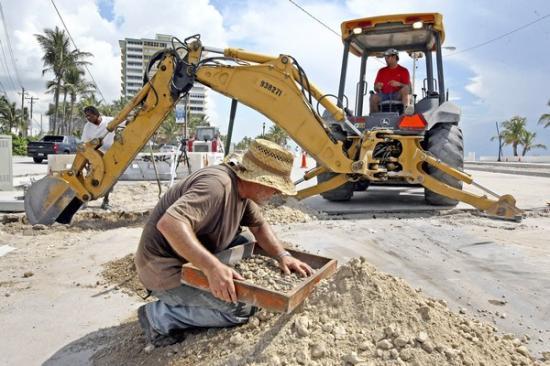Signs of early settlements found on Lauderdale barrier island
Scott Wymam
Source - http://www.orlandosentinel.com/news/local/fl-tequesta-lauderdale-beach-20110723,0,3570073.story
Archaeologists have been uncovering rare evidence in the sandy soil along the barrier island of prehistoric Indians and European explorers living there hundreds of years ago. The artefacts have included leftover conch shells used for food and tools, shards of clay pottery and the bony plates of alligators that had likely been hunted for dinner. They've also found remnants of lead that was being melted for musket balls.
|

|
|
Ray Skinner looks for items at the archaelogical worksite at the city's South Beach parking lot [Credit: Mike Stocker/Sun Sentinel]
|
The most recent discovery came this past week in the southern beach parking lot that the city is renovating near the Bahia Mar resort. Archaeologists discovered indications of a small Tequesta Indian village likely dating back more than 500 years near where they unearthed artefacts from a 19th-century American fort this spring.
The history detectives also want to return to Bonnet House near Sunrise Boulevard and State Road A1A and continue a dig that they began there in late 2008. They say the property was the site not only of another ancient Tequesta village, but of an encampment of 16th-century explorers.
"They are really amazing discoveries when you consider how intensely developed the beach is," said archaeologist Bob Carr, who is leading both excavations. "These are the only two prehistoric sites that have survived on the barrier island in Fort Lauderdale, and what we've found tells a story of the incredible use of this land for hundreds of years."
The pair of sites are about two miles apart and mainly reveal the life of the Tequesta Indians. The Tequesta lived between the Florida Keys and modern-day Boca Raton up until the end of the 1700s and mainly relied on fish, shellfish, nuts and berries for food.
The discovery of Tequesta remnants at the beach's south parking lot came as construction crews were planting trees. Archaeologists have been working ahead of the construction with shovels and screens and found the artefacts about a foot under the old pavement.
In addition to pottery and conch shells, the team unearthed other food waste from the tribe, such as turtle shells, fruit seeds and alligator scutes — the bones that make up the armor plate of the reptile's back. The archaeologists plan to send the material for radiocarbon dating, but believe it is from between 1100 and 1500.
Carr said the discovery shows the military fort was built atop a prehistoric village.

Maj. William Lauderdale built a fort at the site during the Second Seminole War, which lasted from 1835 to 1842. Carr said the location probably appealed to the Tequesta because it was a more of a tropical hammock than barren shore at the time and the original mouth of the New River exited into the Atlantic Ocean nearby.
Curators at the Bonnet House are planning a major exhibit on the archaeological dig there with a walking trail around a re-created excavation. They had been waiting to publicize the discoveries until the plans were finalized.
Carr said the excavation confirms the findings of a small dig undertaken after the late Evelyn Bartlett donated the property for historic preservation in 1983. Scientific tests show the Tequesta had a village on the western ridge of the property dating as far back as the 14th century and that Europeans were in the area around 1540 — less than 50 years after Christopher Columbus' first voyage to America.
The New River is listed on European maps going back to the early 1500s, but the Bonnet House dig is the only archaeological evidence of Europeans in the Fort Lauderdale area at the time.
The 1984 dig uncovered conch shells broken with a metal sword or knife. That raised the likelihood of Europeans being present even though no European artefacts were found. The new dig, though, has unearthed lead slag typical of musket-ball manufacturing.
Carr believes it was a resupply party for English or Dutch explorers, not Spanish, because of the way the earlier shells were opened. The Spanish by the early 1500s knew the technique Indians used to extract conch meat, but these shells were broken differently.
Bonnet House curators depict the discoveries as adding another layer of history for visitors who come to see the beachfront house and gardens built in 1920 by Chicago artist Frederic Clay Bartlett.
"The house is a treasure, but the other aspect of the property is people have found this a good place to live for hundreds of years," Bonnet House executive director Karen Beard said. "The site had fresh water, food to eat and routes to travel on both the ocean and New River. They could get the ocean breeze and be protected from a storm because it was 14 feet above sea level."